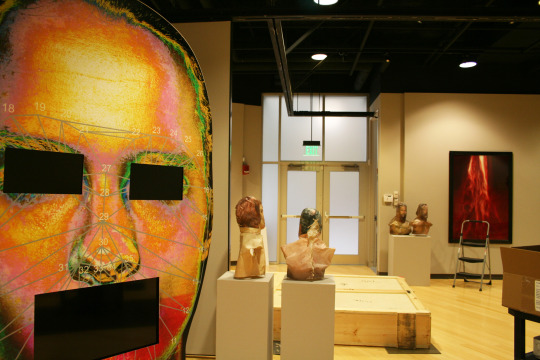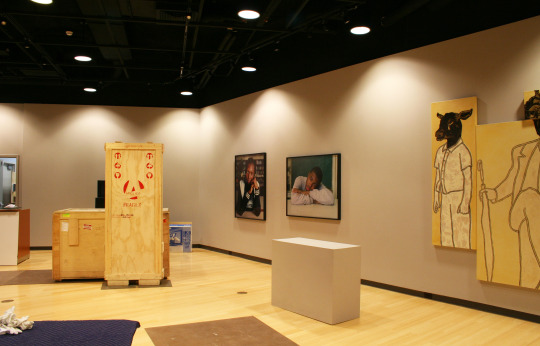Business of Art | Best Practices for Shipping and Handling Your Art
Jonathan Schwartz, President/CEO of Atelier 4, helps artists develop a framework for shipping and handling success.
The New York Foundation for the Arts (NYFA) is commemorating three decades of NYSCA/NYFA Artist Fellowships with the landmark traveling exhibition Artists as Innovators.
Atelier 4, one of the nation’s premier fine art logistics companies, is providing shipping support for the exhibition throughout the show’s run from Fall 2017 through Spring 2020. We spoke with President/CEO Jonathan Schwartz in the lead-up to the exhibition’s opening at SUNY Fredonia’s Cathy and Jesse Marion Art Gallery on February 1, 2019 (details below), and gained insights from the President/CEO on shipping and handling best practices for artists. Read on for Schwartz’s insights.
What to Consider When Shipping and Handling Your Work
In the process of shipping artwork, there are many complex stages that come before the work’s arrival to its final destination. In terms of “best practices,” the process is composed of several steps that are integral yet often overlooked.
My first recommendation is to ask yourself: When do I need these objects to reach their destination? Then, work backwards from there as you consider the following:
1. Loan agreements and insurance coverage. This should be sorted out as far in advance as possible of the date of pick-up.
2. The weight of your artwork. Weight can be a factor, and may necessitate specialized lifting equipment such as a gantry, forklift, block and tackle, etc., which require a higher level of expertise than simple art moving and handling.
3. Packaging and moving prep. What kind of preparation and packing does your object need in order to leave your studio? Does it require any specialized moving equipment? This will all depend on how you are transporting the object (i.e. truck, air, or sea) and how far away you are shipping your object. For example:
- If it is riding with a qualified fine art-handling company (see ICEFAT.org for a list of reputable providers worldwide) via specialized fine art trucks, you might get away with a soft-pack solution.
- If you’re using a consolidated shipment-sharing space with other works going to other places, a more robust wrap is needed. Keep in mind that you will pay a premium for anything you cannot stack or alter.
- Any surface that cannot tolerate contact needs to float in a shadow box, collar, or travel frame.
- Handling and transport via common carrier, air freight, or ocean vessel requires a sound crate or travel case.
4. Access at pick-up and drop-off. Consider the access you will have at both the pick-up and delivery locations (height and width of doorways, elevators, and stairwells; parking restrictions; and prohibited hours of entry).
5. Documentation. International travel requires documentation. If the forms and procedures seem daunting, entrust a reputable fine art logistics company with international experience. Here is a brief, and by no means exhaustive, list of some of the requirements:
- Packing lists and invoices (commercial invoices are needed for definitive exports, like in the case of a sale; and pro forma invoices are for temporary exports, like in the case of an exhibition) are essential.
- Personal or business information is required to arrange export or import entries.
- The composition or medium of an object can require government agency permits such as a phytosanitary certificate (for plants and plant products), fish and wildlife (including feathers, shells, taxidermy, etc.), which is determined by the Convention on International Trade in Endangered Species (CITES).
- There are also other laws in place, such as the Lacey Act (which helps prevent illegal trafficking of plant products), along with others you should research or speak to a fine arts logistics expert about.
- Permits and internationally-recognized treaties such as ATA Carnet (an international customs document that permits the export and import of duty-free nonperishable goods for up to one year) have expiration dates. Keep this in mind when considering the length of exhibition tours.
See below for additional resources and further reading on import and export requirements:
Whether your art shipment is a single object or a mid-career survey, all of these steps are essential. Experienced artists are likely to do some combination of in-house arrangements paired with either commercial or fine art specialty transport assistance, and that can work just fine. If you are new at this, and your tolerance for mishaps and damages is minimal, you’d be well-advised to consult the experts.

Artists as Innovators at SUNY Fredonia
Title: Artists as Innovators: Celebrating Three Decades of New York State Council on the Arts/New York Foundation for the Arts Fellowships
Opening Reception: February 1, 2019, 7:00 PM – 9:00 PM
Visiting Artist Lecture with Jonathan Katz: Thursday, February 21, 8:30 PM
Visiting Artist Lecture with Dread Scott: Thursday, February 28, 8:30 PM
Exhibition Dates: January 22 – March 10, 2019
Location: Cathy and Jesse Marion Art Gallery, Michael C. Rockefeller Arts Center, SUNY Fredonia, 280 Central Avenue, Fredonia, NY 14063
Exhibition Touring Schedule
Summer 2019: The Joseph C. and Joan T. Burke Gallery, SUNY Plattsburgh, May 24 – August 30, 2019, Opening TBD
Fall 2019: Paul W. Zuccaire Gallery, Stony Brook University, Dates and Opening TBD
Spring 2020: Westchester Community College Fine Arts Gallery, Westchester Community College, Dates and Opening TBD
NYSCA/NYFA Artist Fellowships are administered with leadership support from New York State Council on the Arts with the support of Governor Andrew M. Cuomo and the New York State Legislature.
Funding for Artists as Innovators: Celebrating Three Decades of New York State Council on the Arts/New York Foundation for the Arts Fellowships is provided in part by the National Endowment for the Arts (NEA) with shipping support from Atelier 4.

Find out more about the NYSCA/NYFA Artist Fellowship Program, a $7,000 unrestricted cash grant awarded to individual artists living and working in the state of New York.
Images: Artists as Innovators installation at the Cathy and Jesse Marion Art Gallery, Michael C. Rockefeller Arts Center, SUNY Fredonia, Courtesy SUNY Fredonia.





